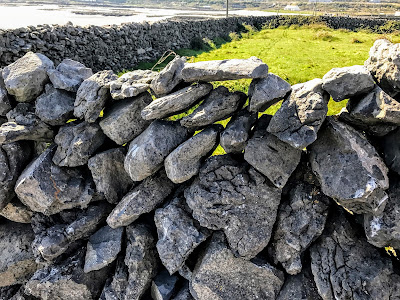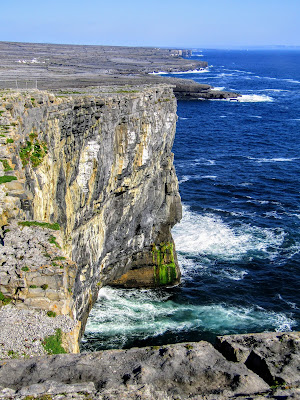Aran Islands
 Aran Islands is one of the most remote places in Ireland and where you will be able to have contact with Irish people who speak Gaelic (Irish) in their day to day. A small place but absolutely charming and full of natural attractions.
Aran Islands is one of the most remote places in Ireland and where you will be able to have contact with Irish people who speak Gaelic (Irish) in their day to day. A small place but absolutely charming and full of natural attractions. Aran Islands is an archipelago of 3 islands located in the Bay of County Galway. The 3 islands are Inisheer (the smallest), Inishmaan (the medium-sized) - and the largest of all, with larger structure and where the absolute majority of tourists visit is Inishmore (or Inis Mór). We left our car in a parking lot in Galway next to where the ferries leave and went to Inishmore.
Aran Islands is an archipelago of 3 islands located in the Bay of County Galway. The 3 islands are Inisheer (the smallest), Inishmaan (the medium-sized) - and the largest of all, with larger structure and where the absolute majority of tourists visit is Inishmore (or Inis Mór). We left our car in a parking lot in Galway next to where the ferries leave and went to Inishmore. The trip takes around 40 minutes, but there is also the possibility of traveling to the island in small planes. The cool thing about taking the ferry is that you enjoy the view.
The trip takes around 40 minutes, but there is also the possibility of traveling to the island in small planes. The cool thing about taking the ferry is that you enjoy the view.
 The ferry arrives in the center of the village. And you already see tourists cycling through the streets, but we preferred to rent a van with a guide on the first day and explore the island on foot the second day.
The ferry arrives in the center of the village. And you already see tourists cycling through the streets, but we preferred to rent a van with a guide on the first day and explore the island on foot the second day. Traffic signs are only in Gaelic.
Traffic signs are only in Gaelic. If you are not sure what to do on the Island there is an information center with plenty of material and attendants to answer some questions.
If you are not sure what to do on the Island there is an information center with plenty of material and attendants to answer some questions. The only hotel in Inishnore is the Aran Islands Hotel and it was where we stayed and we recommend it. Good services and facilities. There are also several B & B's for lodging.
The only hotel in Inishnore is the Aran Islands Hotel and it was where we stayed and we recommend it. Good services and facilities. There are also several B & B's for lodging. As soon as we left the bags at the hotel we already got the van. We did not even stop for lunch, we did not want to stop for a minute to avoid losing the rare sunny day. Our guide was a local resident named Barty, who was really a figure. He had all his van decorated with plush toys as you can see in the picture below.
As soon as we left the bags at the hotel we already got the van. We did not even stop for lunch, we did not want to stop for a minute to avoid losing the rare sunny day. Our guide was a local resident named Barty, who was really a figure. He had all his van decorated with plush toys as you can see in the picture below. Barty was telling us a bit about Aran's day-to-day life. Most people first learn Gaelic and then English. There is a school that even accepts students from all over Ireland and there they only speak Gaelic. The parents send their children so they can practice the language and if the student starts to speak English they are expelled. The landscape of the island is very curious. Almost without trees, and with dozens of stone walls. These walls are made only of stones embedded one above the other and according to the locals they are very resistant because the wind passes between the holes of the stones causing that the walls almost never collapse.
Barty was telling us a bit about Aran's day-to-day life. Most people first learn Gaelic and then English. There is a school that even accepts students from all over Ireland and there they only speak Gaelic. The parents send their children so they can practice the language and if the student starts to speak English they are expelled. The landscape of the island is very curious. Almost without trees, and with dozens of stone walls. These walls are made only of stones embedded one above the other and according to the locals they are very resistant because the wind passes between the holes of the stones causing that the walls almost never collapse. Before we got to the first attraction, this cottage (typical Irish house) caught our eye as there is an identical one next door, only much smaller.
Before we got to the first attraction, this cottage (typical Irish house) caught our eye as there is an identical one next door, only much smaller. Our first stop was the ruins called Seven Churches, historians to this day do not know why the place is called so since there are only two churches. This was one of the first places of Catholic pilgrimage in Ireland. There are several Catholic saints buried in the cemetery next to the churches.
Our first stop was the ruins called Seven Churches, historians to this day do not know why the place is called so since there are only two churches. This was one of the first places of Catholic pilgrimage in Ireland. There are several Catholic saints buried in the cemetery next to the churches.
 The island was a refuge for many Catholics when the Englishman Oliver Cronwell devastated the country and many Catholic temples in the 17th century. And beside the ruins we were delighted with this docile and friendly donkey.
The island was a refuge for many Catholics when the Englishman Oliver Cronwell devastated the country and many Catholic temples in the 17th century. And beside the ruins we were delighted with this docile and friendly donkey. Then we went to the extreme point of the island, near Bungowla where we could see in detail the stony ground known as Burren. Although the arid aspect is an extremely fertile soil and full of life! For you to get an idea 70% of Ireland's native plants thrive on this terrain resembling the lunar soil.
Then we went to the extreme point of the island, near Bungowla where we could see in detail the stony ground known as Burren. Although the arid aspect is an extremely fertile soil and full of life! For you to get an idea 70% of Ireland's native plants thrive on this terrain resembling the lunar soil. And despite being fascinated with the landscape and the Burren, we had to head to one of the biggest attractions of Inishmore which is the Dún Aonghasa fort. The guide dropped us off just before the visitor center where there are several shops selling handicrafts and a restaurant.
And despite being fascinated with the landscape and the Burren, we had to head to one of the biggest attractions of Inishmore which is the Dún Aonghasa fort. The guide dropped us off just before the visitor center where there are several shops selling handicrafts and a restaurant. Since until then we hadn't eaten anything for lunch, we decided to have something there. And we do not regret it. It was one of the best lamb stew we ate to this day. The lasagne was delicious too.
Since until then we hadn't eaten anything for lunch, we decided to have something there. And we do not regret it. It was one of the best lamb stew we ate to this day. The lasagne was delicious too. In the visitor center you pay a small entrance fee and can read lots of information about the cliffs and the Fort of Dun Aonghasa.
In the visitor center you pay a small entrance fee and can read lots of information about the cliffs and the Fort of Dun Aonghasa. The walk to the fort will take about 25 minutes, and the last few meters are a bit steep. But it will be worth it. This is the main prehistoric fort of Inishmore, and is situated on a cliff 100 meters high. From its original construction still can be appreciated some concentric walls that get close to have 4 meters of thickness in some stretches.
The walk to the fort will take about 25 minutes, and the last few meters are a bit steep. But it will be worth it. This is the main prehistoric fort of Inishmore, and is situated on a cliff 100 meters high. From its original construction still can be appreciated some concentric walls that get close to have 4 meters of thickness in some stretches. But what will impress you the most are the fabulous views of the cliffs.
But what will impress you the most are the fabulous views of the cliffs. Then we returned to our van and took a few more rounds around the island and saw that there are also sandy beaches.
Then we returned to our van and took a few more rounds around the island and saw that there are also sandy beaches. At night we enjoyed our hotel had good food and live music and we stayed there.
At night we enjoyed our hotel had good food and live music and we stayed there. But if you still have the will and mood to enjoy the night, an excellent pub that we were well recommended is Watty's.
But if you still have the will and mood to enjoy the night, an excellent pub that we were well recommended is Watty's. The next day we had breakfast. Alex an Irish Breakfast and I had a porridge and we went to the first attraction, another fort and also built on a cliff, the Dún Dúchathair, the walk to the fort is a bit heavy and in some part quite rough. From a certain way, not even with a bicycle you could continue. So it's a good walk with quite a climb.
The next day we had breakfast. Alex an Irish Breakfast and I had a porridge and we went to the first attraction, another fort and also built on a cliff, the Dún Dúchathair, the walk to the fort is a bit heavy and in some part quite rough. From a certain way, not even with a bicycle you could continue. So it's a good walk with quite a climb. The remains of the forts do not draw much attention but the landscapes outweigh any effort.
The remains of the forts do not draw much attention but the landscapes outweigh any effort. When we returned to the small village we wanted to go to the Aran Sweater Market, after all the sweaters of Aran are known for their great quality.
When we returned to the small village we wanted to go to the Aran Sweater Market, after all the sweaters of Aran are known for their great quality. In centuries past the island was so inaccessible that the community had to be self sufficient in virtually everything, So they ended up developing these sweaters with the local sheep wool to face the long, freezing winters. The store is very large and complete, notice for example the different types of stiches that are used.
In centuries past the island was so inaccessible that the community had to be self sufficient in virtually everything, So they ended up developing these sweaters with the local sheep wool to face the long, freezing winters. The store is very large and complete, notice for example the different types of stiches that are used. The products are a bit pricey but they are of quality. I bought this lavender scarf.
The products are a bit pricey but they are of quality. I bought this lavender scarf. In the village there are some good choices of restaurants, we ended up choosing the View Restaurant, with very tasty food and drinks. We ordered pizza, coconut and red fruit smoothies and a latte.
In the village there are some good choices of restaurants, we ended up choosing the View Restaurant, with very tasty food and drinks. We ordered pizza, coconut and red fruit smoothies and a latte. While we were eating we saw our ferry was docking at the port. It was time to leave this incredible island and with wonderful natural beauties.
While we were eating we saw our ferry was docking at the port. It was time to leave this incredible island and with wonderful natural beauties.
Labels
TOURISM



































































































Post A Comment
Nenhum comentário :